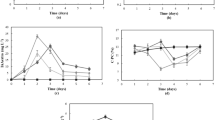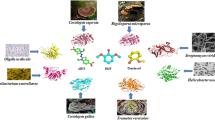Abstract
Monascus pigments (MPs) are widely used natural colorants in Asian countries. The problems of low extracellular red pigment (ERP) and high citrinin remain to be solved in Monascus pigment production. The effect of lanthanum(III) ion (LaCl3) on Monascus purpureus fermentation was investigated in this study. The yields of ERP and biomass respectively reached maxima of 124.10 U/mL and 33.10 g/L by adding 0.4 g/L La3+ on the second day in the total 8-day fermentation; simultaneously, citrinin was decreased by 59.93% and 38.14% in the extracellular and intracellular fractions, respectively. Reactive oxygen species (ROS) levels were obviously improved by La3+ treatment, while the activities of catalase (CAT) and superoxide dismutase (SOD) were increased compared with the control. The ratio of unsaturated/saturated fatty acids in mycelia was increased from 2.94 to 3.49, indicating that the permeability and fluidity of the cell membrane were enhanced under La3+ treatment. Gene expression analysis showed that the relative expression levels of Monascus pigment synthesis genes (pksPT, mppB, mppD, MpFasB2, and MpPKS5) were significantly upregulated by La3+ treatment, and in contrast, the relative expression levels of citrinin synthesis genes (ctnA, pksCT and mppC) were markedly downregulated. This work confirmed that LaCl3 possesses the potential to induce red pigment biosynthesis and inhibit citrinin production in M. purpureus fermentation.
Key points
• La 3+ induced red pigment and inhibited citrinin production in Monascus fermentation.
• La 3+ regulated genes expression up for Monascus pigment and down for citrinin.
• La 3+ increased the UFAs in cell membrane to enhance the permeability and fluidity.





Similar content being viewed by others
Data availability
All data generated or analyzed during this study are included in this published article and its supplementary information files.
References
Adekoya I, Obadina A, Phoku J, Nwinyi O, Njobeh P (2017) Contamination of fermented foods in Nigeria with fungi. LWT Food Sci Technol 86:76–84
Ahsan MK, Lekli I, Ray D, Yodoi J, Das DK (2009) Redox regulation of cell survival by the thioredoxin superfamily: an implication of redox gene therapy in the heart. Antioxid Redox Signal 11:2741–2758
Balakrishnan B, Karki S, Chiu S-H, Kim H-J, Suh J-W, Nam B, Yoon Y-M, Chen C-C, Kwon H-J (2013) Genetic localization and in vivo characterization of a Monascus azaphilone pigment biosynthetic gene cluster. Appl Microbiol Biotechnol 97:6337–6345
Čertík M, Breierová E, Oláhová M, Šajbidor J, Márová I (2013) Effect of selenium on lipid alternations in pigment-forming yeasts. Food Sci Biotechnol 22:45–51
Chai X, Ai Z, Liu J, Guo T, Wu J, Bai J, Lin Q (2020) Effects of pigment and citrinin biosynthesis on the metabolism and morphology of Monascus purpureus in submerged fermentation. Food Sci Biotechnol 29:927–937
Chapkin RS, Young Hong M, Fan Y-Y, Davidson LA, Sanders LM, Henderson CE, Barhoumi R, Burghardt RC, Turner ND, Lupton JR (2002) Dietary n-3 PUFA alter colonocyte mitochondrial membrane composition and function. Lipids 37:193–199
Cheng C-F, Pan T-M (2016) Ankaflavin and monascin induce apoptosis in activated hepatic stellate cells through suppression of the Akt/NF-κB/p38 signaling pathway. J Agric Food Chem 64:9326–9334
Dufossé L (2018) Red colourants from filamentous fungi: are they ready for the food industry? J Food Compos Anal 69:156–161
Erkaya S, Arslan NP, Orak T, Esim N, Taskin M (2020) Evaluation of tyrosol and farnesol as inducer in pigment production by Monascus purpureus ATCC16365. J Basic Microbiol 60:669–678
Feng Y, Shao Y, Chen F (2012) Monascus pigments. Appl Microbiol Biotechnol 96:1421–1440
Han M, Guo W, Liang Z, Yang D, Yan X, Zhu Y, Liu Y (2015) Effects of cerous nitrate on growth and tanshinone production in salvia miltiorrhiza hairy roots. J Rare Earths 33:1228–1235
Hu Z, Richter H, Sparovek G, Schnug E (2004) Physiological and biochemical effects of rare earth elements on plants and their agricultural significance: a review. J Plant Nutr 27:183–220
Huang T, Tan H, Lu F, Chen G, Wu Z (2017a) Changing oxidoreduction potential to improve water-soluble yellow pigment production with Monascus ruber CGMCC 10910. Microb Cell Factories 16:208
Huang T, Wang M, Shi K, Chen G, Tian X, Wu Z (2017b) Metabolism and secretion of yellow pigment under high glucose stress with Monascus ruber. AMB Express 7:79
Huang J, Liao N, Li H (2018) Linoleic acid enhance the production of moncolin K and red pigments in Monascus ruber by activating mokH and mokA, and by accelerating cAMP-PkA pathway. Int J Biol Macromol 109:950–954
Huang Z, Zhang L, Gao H, Wang Y, Li X, Huang X, Huang T (2019) Soybean isoflavones reduce citrinin production by Monascus aurantiacus Li AS3.4384 in liquid state fermentation using different media. J Sci Food Agric 99:4772–4780
Imlay JA (2003) Pathways of oxidative damage. Annu Rev Microbiol 57:395–418
Inaoka T, Ochi K (2011) Scandium stimulates the production of amylase and bacilysin in bacillus subtilis. Appl Environ Microbiol 77:8181–8183
Judson RS, Martin MT, Egeghy P, Gangwal S, Reif DM, Kothiya P, Wolf M, Cathey T, Transue T, Smith D, Vail J, Frame A, Mosher S, Hubal EAC, Richard AM (2012) Aggregating data for computational toxicology applications: the U.S. environmental protection agency (EPA) aggregated computational toxicology resource (ACToR) system. Int J Mol Sci 13:1805–1831
Lee C-I, Lee C-L, Hwang J-F, Lee Y-H, Wang J-J (2013) Monascus-fermented red mold rice exhibits cytotoxic effect and induces apoptosis on human breast cancer cells. Appl Microbiol Biotechnol 97:1269–1278
Liu Q, Xie N, He Y, Wang L, Shao Y, Zhao H, Chen F (2014) MpigE, a gene involved in pigment biosynthesis in Monascus ruber M7. Appl Microbiol Biotechnol 98:285–296
Long C, Zeng X, Xie J, Liang Y, Tao J, Tao Q, Liu M, Cui J, Huang Z, Zeng B (2019) High-level production of Monascus pigments in Monascus ruber CICC41233 through ATP-citrate lyase overexpression. Biochem Eng J 146:160–169
Lu C, Ma Y, Wang J (2019) Lanthanum elicitation on hypocrellin A production in mycelium cultures of Shiraia bambusicola is mediated by ROS generation. J Rare Earths 37:895–902
Lv J, Qian G-F, Chen L, Liu H, Xu H-X, Xu G-R, Zhang B-B, Zhang C (2018) Efficient biosynthesis of natural yellow pigments by Monascus purpureus in a novel integrated fermentation system. J Agric Food Chem 66:918–925
Maxfield FR, Tabas I (2005) Role of cholesterol and lipid organization in disease. Nature 438:612–621
Miranda RU, Gómez-Quiroz LE, Mendoza M, Pérez-Sánchez A, Fierro F, Barrios-González J (2014) Reactive oxygen species regulate lovastatin biosynthesis in Aspergillus terreus during submerged and solid-state fermentations. Fungal Biol 118:979–989
Patakova P (2013) Monascus secondary metabolites: production and biological activity. J Ind Microbiol Biotechnol 40:169–181
Peng L, Yi L, Zhexue L, Juncheng Z, Jiaxin D, Daiwen P, Ping S, Songsheng Q (2004) Study on biological effect of La3+ on Escherichia coli by atomic force microscopy. J Inorg Biochem 98:68–72
Shao Y, Lei M, Mao Z, Zhou Y, Chen F (2014) Insights into Monascus biology at the genetic level. Appl Microbiol Biotechnol 98:3911–3922
Tan H, Xing Z, Chen G, Tian X, Wu Z (2018) Evaluating antitumor and antioxidant activities of yellow Monascus pigments from Monascus ruber fermentation. Molecules 23:3242
Thomas PJ, Carpenter D, Boutin C, Allison JE (2014) Rare earth elements (REEs): effects on germination and growth of selected crop and native plant species. Chemosphere 96:57–66
Wan Y, Zhang J, Han H, Li L, Liu Y, Gao M (2017) Citrinin-producing capacity of Monascus purpureus in response to low-frequency magnetic fields. Process Biochem 53:25–29
Wang M, Huang T, Chen G, Wu Z (2017) Production of water-soluble yellow pigments via high glucose stress fermentation of Monascus ruber CGMCC 10910. Appl Microbiol Biotechnol 101:3121–3130
Wang L, Dai Y, Chen W, Shao Y, Chen F (2016) Effects of light intensity and color on the biomass, extracellular red pigment, and citrinin production of Monascus ruber. J Agric Food Chem 64:9506–9514
Wei D, Deng P, Tian X, He S, Li W, Wu Z (2020) Accelerating the oxidation of pork fat by illumination and fat oil for the production of baijiu beverage. J Sci Food Agric 101:918–926
Wu J, Yang J, Liu Q, Wu S, Ma H, Cai Y (2013) Lanthanum induced primary neuronal apoptosis through mitochondrial dysfunction modulated by Ca2+ and Bcl-2 family. Biol Trace Elem Res 152:125–134
Yang X, Dong Y, Liu G, Zhang C, Cao Y, Wang C (2019) Effects of nonionic surfactants on pigment excretion and cell morphology in extractive fermentation of Monascus sp. NJ1: nonionic surfactants and Monascus extractive fermentation. J Sci Food Agric 99:1233–1239
Yang S, Huang Z, Liu H, Hu X, Wu Z (2020) Improving mycelial morphology and adherent growth as well as metabolism of Monascus yellow pigments using nitrate resources. Appl Microbiol Biotechnol 104:9607–9617
Zakęś Z, Jankowska B, Jarmołowicz S, Żmijewski T, Partyka K, Demska-Zakęś K (2010) Effects of different dietary fatty acids profiles on the growth performance and body composition of juvenile tench (Tinca tinca (L.)). Rev Fish Biol Fish 20:389–401
Zhen Z, Xiong X, Liu Y, Zhang J, Wang S, Li L, Gao M (2019) NaCl inhibits citrinin and stimulates Monascus pigments and monacolin K production. Toxins 11:118
Zhou W, Guo R, Guo W, Hong J, Li L, Ni L, Sun J, Liu B, Rao P, Lv X (2019) Monascus yellow, red and orange pigments from red yeast rice ameliorate lipid metabolic disorders and gut microbiota dysbiosis in wistar rats fed on a high-fat diet. Food Funct 10:1073–1084
Zhu L, Song L, Gao Y, Qian J, Zhang X, Li S (2018) Effects of lanthanum on the growth and essential oil components of lavender under osmotic stress. J Rare Earths 36:891–897
Funding
We gratefully thank Guangdong Key R&D Program, Department of Science and Technology of Guangdong Province (2019B020210002, 2019B040402002), and Guangdong special funds for science and technology innovation strategy, China (2018JK35202003).
Author information
Authors and Affiliations
Contributions
HQL designed and carried out the experiments, analyzed the data, and wrote the manuscript; ZFH, SZY, and XFT assisted to carry out the experiment and revise the manuscript; ZQW designed the experiments, participated in the data analysis, and finalized the manuscript. All authors read and approved the final manuscript.
Corresponding author
Ethics declarations
Ethical approval
This article does not contain any studies with human participants or animals performed by any of the authors.
Conflict of interest
The authors declare that they have no conflict of interest.
Additional information
Publisher’s note
Springer Nature remains neutral with regard to jurisdictional claims in published maps and institutional affiliations.
Supplementary information
ESM 1
(PDF 108 kb)
Rights and permissions
About this article
Cite this article
Liu, Hq., Huang, Zf., Yang, Sz. et al. Inducing red pigment and inhibiting citrinin production by adding lanthanum(III) ion in Monascus purpureus fermentation. Appl Microbiol Biotechnol 105, 1905–1912 (2021). https://doi.org/10.1007/s00253-021-11162-9
Received:
Revised:
Accepted:
Published:
Issue Date:
DOI: https://doi.org/10.1007/s00253-021-11162-9




